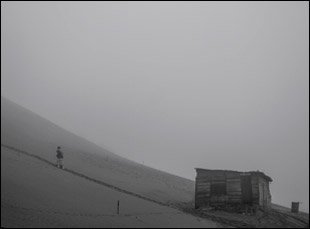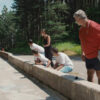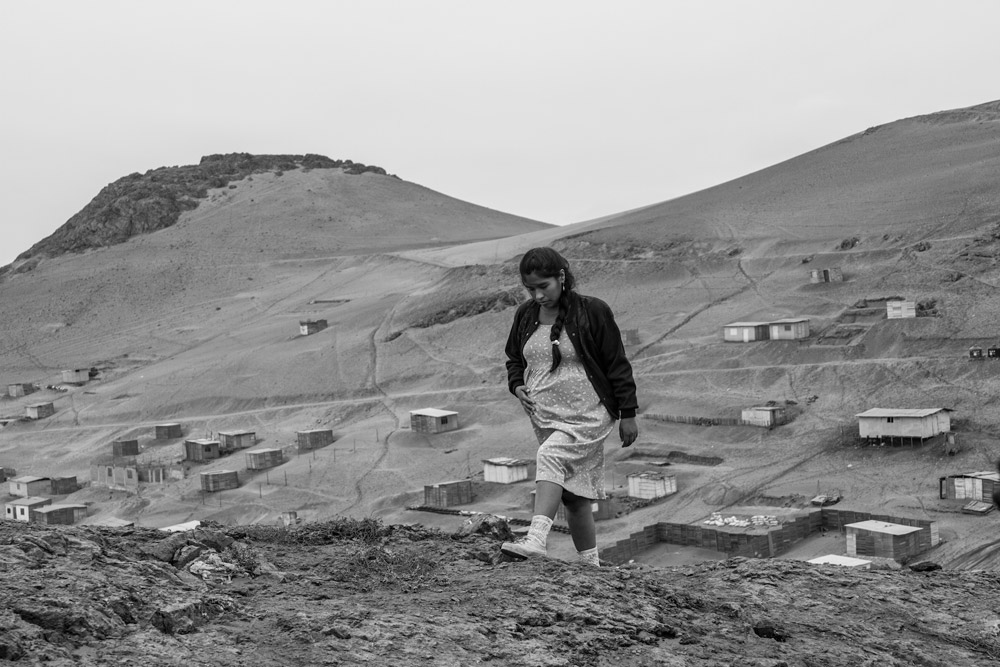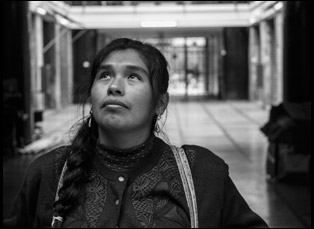It’s hard not to look past the fog in Melina León’s arresting debut “Song Without a Name,” which opens in the highest reaches of the Andes where Georgina (Pamela Mendoza) and her partner Leo (Lucio Rojas) can be seen enjoying a ceremony paying tribute to Mother Earth and Mother Sun. After years of developing her first feature, León decided she could wait slightly longer to shoot in the winter in her native Peru to get the thickness of the mist just right to express what Georgina would be up against as a pregnant Indigenous woman who has to venture into the city to give birth to her first child, required to sell potatoes on the street when she could go into labor at any time. Watching Georgina stoically climb back up the mountains after her day is done is moving enough, but you see her resolve truly come out when León reveals that her lead was one of a number of women in the late 1980s who placed their trust in the wrong hands as society was completely destabilized by political corruption and the guerrilla organization Shining Path attempted to fill the void through violence.
The inclement weather and the trying topography soon seems like nothing when Georgina attempts to navigate the local bureaucracy after awakening from her time to labor to find that her baby is nowhere to be found and the once-kindly nurses who told her to rest up likely didn’t have her best interests at heart, and as she seeks out the help of a journalist name Pedro (Tommy Párraga), “Song Without a Name” becomes a moving drama about an entire generation in Peru that could feel as if their humanity was stolen away from them at a time when those in power had little regard for those who had none, a situation that only magnified what had already been taken over the years from the indigenous community. Even without the contemporary echoes that can be felt around the world in this present moment, León’s film drew appreciative gasps when it premiered last year at the Directors Fortnight at Cannes where the filmmaker was the first female Peruvian to present a film in the festival’s history. With the film now arriving in virtual cinemas, León spoke about how the story runs in her family, working with a mix of professional and nonprofessional actors and the role of music in the film.
My father was a journalist and at the beginning of the ‘80s, he was the one who published this story about this real case of trafficking of babies. Many years later, around 2006, he received a phone call from a French woman who wanted to meet him because she was one of the babies that got stolen from 30 years before. She discovered old newspapers where she saw that her biological mother was looking for her and she managed to meet her. So he called me when I was living in New York at the time and told me this unbelievable story and making my first film, I knew I was going to have to spend a lot of time and effort to make it, so I thought I could live with this story for a long time and it was personal enough and strong enough to go on a marathon with it.
Something quite interesting structurally is that you introduce Pedro the reporter quite early, though it’s clearly Georgina’s story, before they intersect onscreen. How did that come to mind?
From the very beginning, because it’s inspired by real events, I figured it was important to have a character that is a journalist and then I was inspired by my father, but then I I wanted this character to have a life, not to exist only because of this case. I was looking to make an honest film and I think we have many sides as people, so I wanted see many layers of this character’s life even though in many ways he’s a secondary character. So I decided to see a bit of his life before he meets Georgina and also to show his personal life — of course, to my knowledge, my father was not gay, so it’s a fiction. [laughs] But I felt I identified more with this character because we are so mixed in Peru, when I was writing him as a sort of white heterosexual man, it was somehow symbolizing power and I wanted him to really know how it is to have an identity that is not approved or marginalized or even disregarded.
I’ve heard the idea of old newspapers and the media shaped the visual approach. How did you go about it?
That’s true. I thought it would be very organic to do it in black and white because our memory in those times is the memory of those photographs that were in the press and during those years, the press was only doing black-and-white. They used some colors, but only for the graphics and practically, we had a very low budget and of course, having color would’ve been much more expensive, and easier to make mistakes in the accuracy. I heard Haneke once say about “The White Ribbon,” that was one of his reasons to do “White Ribbon” in black and white, and I thought if he does it with his budget, we should be concerned as well. [laughs]

Yeah, it was important to go back to Villa El Salvador because it’s very symbolic. It’s a big neighborhood that that was led by this progressive major for a long time and they assassinated a young, African-Peruvian [female] leader [María Elena Moyano] at an event that she was doing [there] and things like this happened [there], so there was a lot of power for me to go back to that place. We ended up not shooting there [specifically] because it’s changed a lot, and we had to go somewhere else that looks like it, but we call it Villa and we went to the opposite side of Lima, a place called Ventanilla that’s a new shantytown. And where Pedro lives, it’s called San Felipe, a very well-known group of buildings called “Residentiale” surrounded by mini-gardens. The architecture there is very interesting — modern and expressionist, and I happened to go to school nearby — there’s a school in that group of buildings, among all those buildings, so it’s very close to me. I know it very well and I thought this labyrinthine architecture expresses a little bit my feelings towards this society and this specific time.
When you’re telling the story of a generation just before yours, is it interesting to bridge the gap by connecting with them within the production? Besides talking to your father, I’ve heard Pamela’s mother translated some of indigenous dialogue for her.
Yeah, we felt like it was not our generation, that’s for sure, and it felt like a big responsibility for Pamela because in a way she’s telling the story of her own mother. Not specifically [because] it’s not like she was taken away from her mother, but definitely in terms of her mother’s social situation. She’s telling the story of all that generation that came to Lima as immigrants during the end of the ‘70s and throughout the entire decade of the ‘80s, so Pamela, in her childhood, experienced a similar situation [when] they came to Lima to live in the desert, as you see in the film, because there was war in the Andes. And of course I was approaching my father’s generation, so I definitely talked to not only my father, but other journalists of his generation as part of the research process to try to understand the feeling and the attitudes, and also I remember a lot, having grown up in such an environment.
I understand a lot of the cast was nonprofessional – are there surprises when you’re mixing them with professional actors?
I love it. It’s more exciting because there’s no rules. For example, Pamela wanted to change and try new things in each take and because some of the other cast are professional actors like Tommy Párraga [who plays] Pedro, he was disconcerted many times when she tried to change her dialogue and tone. But to me, it was fantastic. I love to try new things, so I encouraged them and I knew there was some nervousness, but I felt it was positive in the end. [There was] a lot of input because they were telling me their own stories and contributing to the script – like that first ceremony that you see in the film, that was a suggestion of [Maykol Hernández, the actress who plays] Isa, the friend of Georgina in the film that appears in the beginning in the celebration.
In the script, we actually had a birthday party and when we were discussing it with these non-actors, we became friends and thank God, they trusted me with their opinion. I said, “What do you think of this?” And they said, “I don’t know about a birthday. This could be more interesting.” And they suggested this ceremony where they pay homage to the earth and also the bless the costume of the dancer. So that was their idea. It wasn’t mine, and as non-actors, they didn’t have the script in their hands, so there was not such reverence towards the [source material], and the fact that they were non-actors made it possible to have this attitude where we create together.
The live music in that scene and others is a really wonderful element in the film. Was that always in the film?
Yeah, that was always in the script. I thought the music was going to help us express many things better than words and dance and music are the most beautiful part of our culture. I didn’t want the film to start with a tragedy. It was very important because in these [stories about] ”modern Peru,” there is a tendency to relate the Andean as sad or poor in a way as if all that sadness or poverty was intrinsic to the people and it’s not like that. I wanted to show the hope in the beginning, and [involve this] heartless act, but balance it out with the beauty of the Andean culture, the strength of their people [because] there’s a lot of richness and beauty and hope and joy. It’s taken away by how this country doesn’t work, but it’s not intrinsic, so that’s why it was important for me to show it.
That must resonate around the world where so many have fallen on tough times. Before the pandemic, what was it like traveling with it?
Around the world, it’s been amazing how people have responded. Unfortunately, we couldn’t release it in Peru because of the COVID. Yeah, it was terrible. We were supposed to have a premiere at the beginning of June, in one of these neighborhoods I told you about, but it was not permitted. We had a little bit of a reaction last year at the Lima Film Festival where all four screenings were full. Everything got sold out the same day, so that was wonderful and the fact it got invited to a hundred festivals all over the world was really moving. It tells you a lot about the possibilities that film gives us to communicate and to relate.
“Song Without a Name” opens on August 7th in virtual cinemas.





